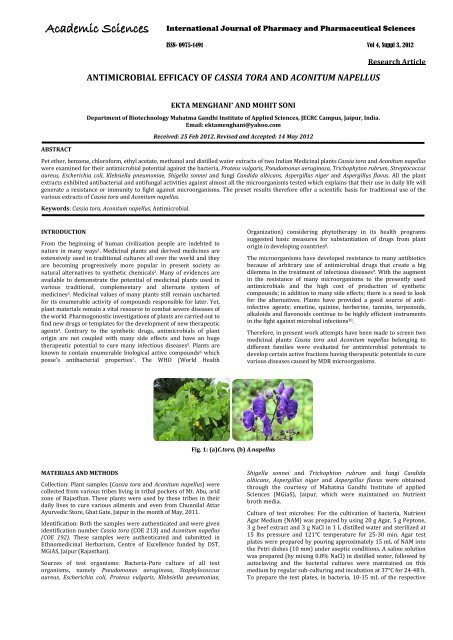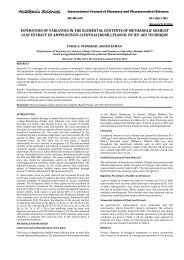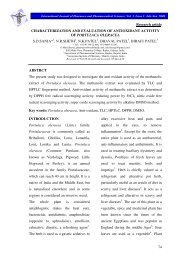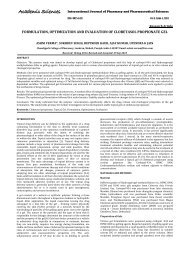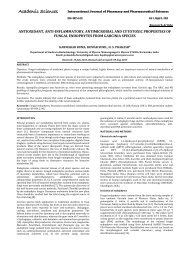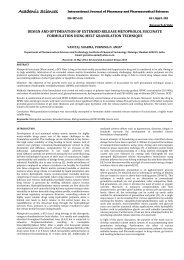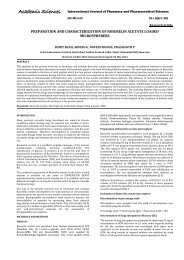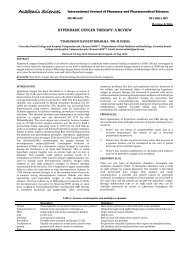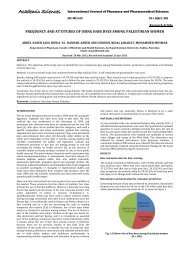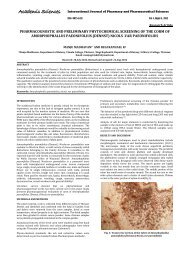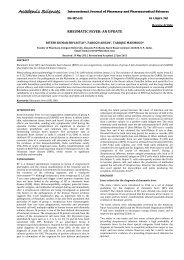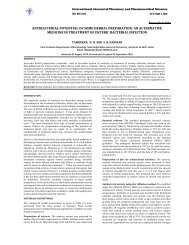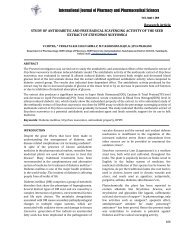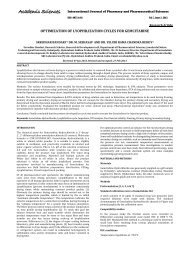Antimicrobial Efficacy of Cassia tora and Aconitum napellus
Antimicrobial Efficacy of Cassia tora and Aconitum napellus
Antimicrobial Efficacy of Cassia tora and Aconitum napellus
You also want an ePaper? Increase the reach of your titles
YUMPU automatically turns print PDFs into web optimized ePapers that Google loves.
Academic Sciences<br />
ABSTRACT<br />
ANTIMICROBIAL EFFICACY OF CASSIA TORA AND ACONITUM NAPELLUS<br />
EKTA MENGHANI * AND MOHIT SONI<br />
Department <strong>of</strong> Biotechnology Mahatma G<strong>and</strong>hi Institute <strong>of</strong> Applied Sciences, JECRC Campus, Jaipur, India.<br />
Email: ektamenghani@yahoo.com<br />
Received: 25 Feb 2012, Revised <strong>and</strong> Accepted: 14 May 2012<br />
Research Article<br />
Pet ether, benzene, chlor<strong>of</strong>orm, ethyl acetate, methanol <strong>and</strong> distilled water extracts <strong>of</strong> two Indian Medicinal plants <strong>Cassia</strong> <strong>tora</strong> <strong>and</strong> <strong>Aconitum</strong> <strong>napellus</strong><br />
were examined for their antimicrobial potential against the bacteria, Proteus vulgaris, Pseudomonas aeruginosa, Trichophyton rubrum, Streptococcus<br />
aureus, Escherichia coli, Klebsiella pneumoniae, Shigella sonnei <strong>and</strong> fungi C<strong>and</strong>ida albicans, Aspergillus niger <strong>and</strong> Aspergillus flavus. All the plant<br />
extracts exhibited antibacterial <strong>and</strong> antifungal activities against almost all the microorganisms tested which explains that their use in daily life will<br />
generate a resistance or immunity to fight against microorganisms. The preset results therefore <strong>of</strong>fer a scientific basis for traditional use <strong>of</strong> the<br />
various extracts <strong>of</strong> <strong>Cassia</strong> <strong>tora</strong> <strong>and</strong> <strong>Aconitum</strong> <strong>napellus</strong>.<br />
Keywords: <strong>Cassia</strong> <strong>tora</strong>, <strong>Aconitum</strong> <strong>napellus</strong>, <strong>Antimicrobial</strong>.<br />
INTRODUCTION<br />
From the beginning <strong>of</strong> human civilization people are indebted to<br />
nature in many ways1 . Medicinal plants <strong>and</strong> derived medicines are<br />
extensively used in traditional cultures all over the world <strong>and</strong> they<br />
are becoming progressively more popular in present society as<br />
natural alternatives to synthetic chemicals2 . Many <strong>of</strong> evidences are<br />
available to demonstrate the potential <strong>of</strong> medicinal plants used in<br />
various traditional, complementary <strong>and</strong> alternate system <strong>of</strong><br />
medicines3 . Medicinal values <strong>of</strong> many plants still remain uncharted<br />
for its enumerable activity <strong>of</strong> compounds responsible for later. Yet,<br />
plant materials remain a vital resource to combat severe diseases <strong>of</strong><br />
the world. Pharmogonostic investigations <strong>of</strong> plants are carried out to<br />
find new drugs or templates for the development <strong>of</strong> new therapeutic<br />
agents4 . Contrary to the synthetic drugs, antimicrobials <strong>of</strong> plant<br />
origin are not coupled with many side effects <strong>and</strong> have an huge<br />
therapeutic potential to cure many infectious diseases5 . Plants are<br />
known to contain enumerable biological active compounds6 which<br />
posse’s antibacterial properties7 . The WHO (World Health<br />
MATERIALS AND METHODS<br />
Collection: Plant samples (<strong>Cassia</strong> <strong>tora</strong> <strong>and</strong> <strong>Aconitum</strong> <strong>napellus</strong>) were<br />
collected from various tribes living in tribal pockets <strong>of</strong> Mt. Abu, arid<br />
zone <strong>of</strong> Rajasthan. These plants were used by these tribes in their<br />
daily lives to cure various ailments <strong>and</strong> even from Chunnilal Attar<br />
Ayurvedic Store, Ghat Gate, Jaipur in the month <strong>of</strong> May, 2011.<br />
Identification: Both the samples were authenticated <strong>and</strong> were given<br />
identification number <strong>Cassia</strong> <strong>tora</strong> (COE 213) <strong>and</strong> <strong>Aconitum</strong> <strong>napellus</strong><br />
(COE 192). These samples were authenticated <strong>and</strong> submitted in<br />
Ethnomedicinal Herbarium, Centre <strong>of</strong> Excellence funded by DST,<br />
MGiAS, Jaipur (Rajasthan).<br />
Sources <strong>of</strong> test organisms: Bacteria-Pure culture <strong>of</strong> all test<br />
organisms, namely Pseudomonas aeruginosa, Staphylococcus<br />
aureus, Escherichia coli, Proteus vulgaris, Klebsiella pneumoniae,<br />
International Journal <strong>of</strong> Pharmacy <strong>and</strong> Pharmaceutical Sciences<br />
ISSN- 0975-1491 Vol 4, Suppl 3, 2012<br />
Fig. 1: (a)C.<strong>tora</strong>, (b) A.<strong>napellus</strong><br />
Organization) considering phytotherapy in its health programs<br />
suggested basic measures for substantiation <strong>of</strong> drugs from plant<br />
origin in developing countries8. The microorganisms have developed resistance to many antibiotics<br />
because <strong>of</strong> arbitrary use <strong>of</strong> antimicrobial drugs that create a big<br />
dilemma in the treatment <strong>of</strong> infectious diseases9<br />
. With the augment<br />
in the resistance <strong>of</strong> many microorganisms to the presently used<br />
antimicrobials <strong>and</strong> the high cost <strong>of</strong> production <strong>of</strong> synthetic<br />
compounds; in addition to many side effects; there is a need to look<br />
for the alternatives. Plants have provided a good source <strong>of</strong> antiinfective<br />
agents; emetine, quinine, berberine, tannins, terpenoids,<br />
alkaloids <strong>and</strong> flavonoids continue to be highly efficient instruments<br />
in the fight against microbial infections10. Therefore, in present work attempts have been made to screen two<br />
medicinal plants <strong>Cassia</strong> <strong>tora</strong> <strong>and</strong> <strong>Aconitum</strong> <strong>napellus</strong> belonging to<br />
different families were evaluated for antimicrobial potentials to<br />
develop certain active fractions having therapeutic potentials to cure<br />
various diseases caused by MDR microorganisms.<br />
Shigella sonnei <strong>and</strong> Trichophton rubrum <strong>and</strong> fungi C<strong>and</strong>ida<br />
albicans, Aspergillus niger <strong>and</strong> Aspergillus flavus were obtained<br />
through the courtesy <strong>of</strong> Mahatma G<strong>and</strong>hi Institute <strong>of</strong> applied<br />
Sciences (MGiaS), Jaipur, which were maintained on Nutrient<br />
broth media.<br />
Culture <strong>of</strong> test microbes: For the cultivation <strong>of</strong> bacteria, Nutrient<br />
Agar Medium (NAM) was prepared by using 20 g Agar, 5 g Peptone,<br />
3 g beef extract <strong>and</strong> 3 g NaCl in 1 L distilled water <strong>and</strong> sterilized at<br />
15 lbs pressure <strong>and</strong> 121°C temperature for 25-30 min. Agar test<br />
plates were prepared by pouring approximately 15 mL <strong>of</strong> NAM into<br />
the Petri dishes (10 mm) under aseptic conditions. A saline solution<br />
was prepared (by mixing 0.8% NaCl) in distilled water, followed by<br />
autoclaving <strong>and</strong> the bacterial cultures were maintained on this<br />
medium by regular sub-culturing <strong>and</strong> incubation at 37°C for 24-48 h.<br />
To prepare the test plates, in bacteria, 10-15 mL <strong>of</strong> the respective
medium was poured into the Petri plates <strong>and</strong> used for screening. For<br />
assessing the bactericidal efficacy, a fresh suspension <strong>of</strong> the test<br />
bacteria was prepared in saline solution from a freshly grown Agar<br />
slant.<br />
Preparation <strong>of</strong> test extracts: Crushed powder (50 g) <strong>of</strong> all the species<br />
were successively soxhlet extracted with ethanol. Later, each <strong>of</strong> the<br />
homogenates was filtered <strong>and</strong> the residue was re-extracted twice for<br />
complete exhaustion, the extracts were pooled individually. Each<br />
filtrate was concentrated to dryness in vitro <strong>and</strong> redissolved in<br />
respective solvents, out <strong>of</strong> which 80 mg/10 disc i.e. 8 mg/disc<br />
concentration were stored at 4°C in a refrigerator, until screened for<br />
antibacterial activity.<br />
Bactericidal assay: For both, bactericidal in vitro Disc diffusion<br />
method was adopted (Gould <strong>and</strong> Bowie, 1952), because <strong>of</strong><br />
reproducibility <strong>and</strong> precision. The different test organisms were<br />
proceeded separately using a sterile swab over previously sterilized<br />
culture medium plates <strong>and</strong> the zone <strong>of</strong> inhibition were measured<br />
around sterilized dried discs <strong>of</strong> Whattman No. 1 paper (5 mm in<br />
diameter), which were containing 1mg, 5mg <strong>and</strong> 10mg <strong>of</strong> the text<br />
extracts <strong>and</strong> reference drugs (tetracycline <strong>and</strong> mycostatin for<br />
bacteria <strong>and</strong> fungi, respectively) separately. Such treated discs were<br />
Menghani et al.<br />
Int J Pharm Pharm Sci, Vol 4, Suppl 3, 700-702<br />
air-dried at room temperature to remove any residual solvent,<br />
which might interfere with the determination, sterilized <strong>and</strong><br />
inoculated. These plates were initially placed at low temperature for<br />
1 h so as to allow the maximum diffusion <strong>of</strong> the compounds from the<br />
test disc into the agar plate <strong>and</strong> later, incubated at 37°C for 24 h in<br />
case <strong>of</strong> bacteria <strong>and</strong> ˚C in case <strong>of</strong> fungi, after which the zones <strong>of</strong><br />
inhibition could be easily observed. Five replicates <strong>of</strong> each test<br />
extract were examined <strong>and</strong> the mean values were then referred. The<br />
Inhibition Zone (IZ) in each case were recorded <strong>and</strong> the Activity<br />
Index (AI) was calculated as compared with those <strong>of</strong> their respective<br />
st<strong>and</strong>ard reference drugs (AI = Inhibition Zone <strong>of</strong> test<br />
sample/Inhibition zone <strong>of</strong> st<strong>and</strong>ard).<br />
RESULTS<br />
The pr<strong>of</strong>ile <strong>of</strong> the medicinal plants used in the present investigation.<br />
The results <strong>of</strong> antimicrobial activity <strong>of</strong> the crude extracts <strong>of</strong> selected<br />
Indian Medicinal Plants (<strong>Cassia</strong> <strong>tora</strong> <strong>and</strong> <strong>Aconitum</strong> <strong>napellus</strong>) showed<br />
good antimicrobial activity against selected test bacteria <strong>and</strong> fungi<br />
(Table 1 <strong>and</strong> 2). Overall, these extracts showed appreciable activity<br />
against selected test bacteria <strong>and</strong> fungi <strong>and</strong> hence, it justifies their<br />
use in our traditional system <strong>of</strong> medicine to cure various diseases<br />
(fig.1 <strong>and</strong> 2).<br />
Table 1: Antibacterial <strong>Efficacy</strong> <strong>of</strong> <strong>Cassia</strong> <strong>tora</strong> in terms <strong>of</strong> inhibition zone against selected bacteria <strong>and</strong> fungi<br />
<strong>Cassia</strong> <strong>tora</strong> Measure Bacteria Fungi<br />
Extracts<br />
P.<br />
P.<br />
T. S. E. K.<br />
S. C.<br />
A. A.<br />
vulgaris aeruginosa rubrum aureus coli pneumoniae sonnei albicans niger flavus<br />
St<strong>and</strong>ard<br />
I.Z.<br />
9.1 9.9 10.9 17.9 9.8 12.3 11.9 11.4 9.7 11.8<br />
Pet ether I.Z. (mm) 6.3 7.5 4.3 8.3 16 16.6 11.6 11.3 11 6<br />
A.I. 0.692 0.757 0.394 0.463 1.632 1.349 0.974 0.991 1.134 0.508<br />
Benzene I.Z.*(mm) 8.6 9.6 12 13.6 8.3 11.3 11.6 9 14.6 13.3<br />
A.I. 0.945 0.969 1.100 0.759 0.846 0.918 0.974 0.789 1.505 1.127<br />
Chlor<strong>of</strong>orm I.Z. (mm) 12.3 8.5 6.6 9.6 9.3 7 8.6 20.3 11.3 6.6<br />
A.I. 1.351 0.858 0.6.5 0.536 0.948 0.569 0.722 1.780 1.164 0.559<br />
Ethyl<br />
Acetate<br />
I.Z. (mm) 12.6 10.6 10.6 13.6 10.6 9.3 9.6 6.6 7.5 7<br />
A.I. 1.384 1.707 0.972 0.759 1.081 0.756 0.806 0.578 0.773 0.593<br />
Methanol I.Z. (mm) 11 16 8.3 9.3 8 8 12.3 12.3 13.6 11.3<br />
A.I. 1.208 1.616 0.761 0.519 0.816 0.650 1.033 1.078 1.402 0.957<br />
Distilled<br />
Water<br />
I.Z. (mm) 7 8 7.5 12 7.5 10 10.6 14.3 8.3 10.3<br />
A.I. 0.769 0.808 0.688 0.670 0.765 0.813 0.890 1.254 0.855 0.872<br />
I.Z. = Inhibition zone, A.I. = Activity index<br />
*I.Z. in mm are the mean value <strong>of</strong> the triplicates <strong>Aconitum</strong> <strong>napellus</strong><br />
Table 2: Antibacterial <strong>Efficacy</strong> <strong>of</strong> <strong>Aconitum</strong> <strong>napellus</strong> in terms <strong>of</strong> inhibition zone against selected bacteria <strong>and</strong> fungi<br />
<strong>Aconitum</strong><br />
Measure Bacteria Fungi<br />
<strong>napellus</strong><br />
P. P.<br />
T. S. E. K.<br />
S. C. A. A.<br />
Extracts<br />
vulgaris aeruginosa rubrum aureus coli pneumoniae sonnei albicans niger flavus<br />
St<strong>and</strong>ard<br />
I.Z.<br />
9.1 9.9 10.9 17.9 9.8 12.3 11.9 11.4 9.7 11.8<br />
Pet ether I.Z.*(mm) 6.6 9.6 9.3 10 7.6 7.6 10 9.5 15.6 10<br />
A.I. 0.725 0.969 0.853 0.558 0.775 0.617 0.840 0.833 1.608 0.847<br />
Benzene I.Z. (mm) 7.3 10.5 7.6 8 7.6 8.3 10 14 17.3 10.5<br />
A.I. 0.802 1.606 0.697 0.446 0.775 0.674 0.840 1.228 1.783 0.889<br />
Chlor<strong>of</strong>orm I.Z. (mm) 6.6 8.3 11.6 8 11 6 9.3 10 7 8<br />
A.I. 0.725 0.838 1.064 0.446 1.122 0.487 0.781 0.877 0.721 0.677<br />
Ethyl<br />
Acetate<br />
I.Z. (mm) 7.6 9 5 9.6 9.6 9 15 9.3 6.5 6.3<br />
A.I. 0.835 0.909 0.458 0.536 0.979 0.731 1.260 0.815 0.670 0.533<br />
Methanol I.Z. (mm) 8 12 6.3 9.6 8.3 6 11.3 10 8 -<br />
A.I. 0.879 1.212 0.577 0.536 0.846 0.487 0.949 0.877 0.824 -<br />
Distilled<br />
Water<br />
I.Z. (mm) 11.3 7 5.3 10.3 8.3 8 12.6 11.3 13 12<br />
A.I. 1.241 0.707 0.486 0.575 0.846 0.650 1.058 0.991 1.340 1.016<br />
I.Z. = Inhibition zone, A.I. = Activity index<br />
*I.Z. in mm are the mean value <strong>of</strong> the triplicates<br />
701
<strong>Cassia</strong> <strong>tora</strong><br />
While screening the extracts <strong>of</strong> <strong>Cassia</strong> <strong>tora</strong> the, good antimicrobial<br />
activity against the selected bacteria <strong>and</strong> fungi was observed. The<br />
various extracts were found active against all the bacteria <strong>and</strong><br />
fungi tested. Results, comparable to the st<strong>and</strong>ards, were found<br />
against P.aeruginosa (7.5mm), S.Sonnei (11.6mm), C.albicans<br />
(11.3mm) (pet ether extract), P.vulgaris (8.6mm), P.aeruginosa<br />
(9.6mm), S.aereus (13.6mm), E.coli (8.3mm), K.pneumoniae<br />
(11.3mm), S.sonnei (11.6mm), C.albicans (9mm) (benzene extract),<br />
P.aeruginosa (8.5mm), E.coli (9.3mm), S.sonnei (8.6) (chlor<strong>of</strong>orm<br />
extract), T.rubrum (10.6mm), S.aureus (13.6mm), K.pneumoniae<br />
(9.3mm), S.sonnei (9.6mm), A.niger (7.5mm) (ethyl acetate<br />
extract), T.rubrum (8.3mm), E.coli (8mm) (methanol extract),<br />
P.vulgaris (7mm), P.aeruginosa (8mm), E.coli (7.5mm),<br />
K.pneumoniae (10mm), S.sonnei (10.6mm), A.niger (8.3mm) <strong>and</strong><br />
A.flavus (10.3mm) (aqueous extract). <strong>Antimicrobial</strong> activity<br />
greater than the activity <strong>of</strong> the st<strong>and</strong>ard was observed against<br />
E.coli (16mm), K.pneumoniae (16.6mm), A.niger (11mm) (pet ether<br />
extract), T.rubrum (12mm), A.niger (14.6mm), A.flavus (13.3mm)<br />
(benzene extract), P.vulgaris (12.3mm), C.albicans (20.3mm),<br />
A.niger (11.3mm) (chlor<strong>of</strong>orm extract), P.vulgaris (12.6mm),<br />
P.aeruginosa (10.6mm), E.coli (10.6mm) (ethyl acetate), P.vulgaris<br />
(11mm), P.aeruginosa (16mm), S.sonnei (12.3mm), C.albicans<br />
(12.3mm) <strong>and</strong> A.niger (13.6mm) (methanol extract) <strong>and</strong> C.albicans<br />
(14.3mm) (aqueous extract).<br />
While screening the extracts <strong>of</strong> <strong>Aconitum</strong> <strong>napellus</strong>, good<br />
antimicrobial activity against the selected bacteria <strong>and</strong> fungi was<br />
observed. The various extracts were found active against all the<br />
bacteria <strong>and</strong> fungi tested. Results, comparable to the st<strong>and</strong>ard,<br />
were obtained against P.vulgaris (6.6mm), P,aeruginosa (9.6mm),<br />
T.rubrum (9.3mm), E.coli (7.6mm), S.sonnei (10mm), C.albicans<br />
(9.5mm), A.flavus (10mm) (pet ether extract), P.vulgaris (7.3mm),<br />
E.coli (7.6mm), S.sonnei (10mm), A.flavus (10.5mm) (benzene<br />
extract), P.vulgaris (6.6mm), P.aeruginosa (8.3mm), S.sonnei<br />
(9.3mm), C.albicans (10mm), A.niger (7mm) (chlor<strong>of</strong>orm extract),<br />
P.vulgaris (7.6mm), P.areuginosa (9mm), E.coli (9.6mm),<br />
K.pneumoniae (9mm), C.albicans (9.3mm) (ethyl acetate extract),<br />
P.vulgaris (8mm), E.coli (8.3mm), S.sonnei (11.3mm), C.albicans<br />
(10mm), A.niger (13mm) (methanol extract), P.aeruginosa (7mm),<br />
E.coli (8.3mm) <strong>and</strong> C.albicans (11.3mm) (aqueous extract).<br />
<strong>Antimicrobial</strong> activity, higher than the activity <strong>of</strong> the st<strong>and</strong>ard, was<br />
observed against A.niger (15.6mm) (pet ether), P.aeruginosa<br />
(10.5mm), C.albicans (14mm), A.niger (17.3mm) (benzene<br />
extract), T.rubrum (11.6mm), E.coli (11mm) (chlor<strong>of</strong>orm extract),<br />
S.sonnei (15mm) (ethyl acetate extract), P.aeruginosa (12mm)<br />
(methanol extract), P.vulgaris (11.3mm), S.sonnei (12.6mm),<br />
A.niger (13mm) <strong>and</strong> A.flavus (12mm) (aqueous extract). The<br />
methanol extract <strong>of</strong> the plant showed no activity against the<br />
fungus A.flavus.<br />
Menghani et al.<br />
DISCUSSION<br />
Int J Pharm Pharm Sci, Vol 4, Suppl 3, 700-702<br />
The versatile medicinal plants are the unique source <strong>of</strong> various types<br />
<strong>of</strong> compounds having diverse chemical structures. Very little work<br />
has been done on the biological activity <strong>and</strong> plausible medicinal<br />
applications <strong>of</strong> these compounds <strong>and</strong> hence extensive investigation<br />
is needed to exploit their therapeutic utility to combat diseases.<br />
The present results therefore <strong>of</strong>fer a scientific basis for traditional<br />
use <strong>of</strong> the various extracts <strong>of</strong> <strong>Cassia</strong> <strong>tora</strong> <strong>and</strong> <strong>Aconitum</strong> <strong>napellus</strong>.<br />
These results explain that Indian Medicinal Plants have potentials as<br />
antimicrobials. Further, more or less both the selected Indian<br />
Medicinal Plants have also possessed antimicrobial potential against<br />
all test bacteria <strong>and</strong> fungi which explains that their use in daily life<br />
will generate a resistance or immunity to fight against<br />
microorganisms.<br />
ACKNOWLEDGEMENT<br />
Author acknowledge with thanks the financial support from<br />
Department <strong>of</strong> Science <strong>and</strong> Technology, Government <strong>of</strong> Rajasthan, in<br />
the form <strong>of</strong> Centre with Potentials for Excellence in Biotechnology,<br />
sanction no F 7(17) (9) Wipro/Gaprio/2006/7358-46(31/10/2008).<br />
REFERENCES<br />
1. Banerjee S, Mitra A Changing L<strong>and</strong>scape <strong>of</strong> Herbal Medicine:<br />
Technology Attributing Renaissance. International Journal <strong>of</strong><br />
Pharmacy <strong>and</strong> Pharmaceutical Science 2012; 4(1): 47-52.<br />
2. Vanwyk B, Wink M Medicinal Plant <strong>of</strong> the World. 2nd ed. Briz<br />
Publication, South Africa. 2009. 43.<br />
3. Kachhawa JBS, Sharma N, Tyagi S, Gupta RS, Sharma KK In vitro<br />
Evaluation <strong>of</strong> Antibacterial Activity <strong>of</strong> Pterocarpus marsupium<br />
ROXB. International Journal Pharmacy <strong>and</strong> Pharmaceutical<br />
Science 2012; 4(1): 67-68.<br />
4. Konig GM Meeresorganismen als Quelle pharmazeutisch<br />
bedeutsamer Naturst<strong>of</strong>fe. Deutsche Apotheker Zeitung 1992;<br />
132 (14): 673-683.<br />
5. Iwu MW, Ducan AR New <strong>Antimicrobial</strong>s <strong>of</strong> Plant Origin. Janik J.<br />
Perspectives on New Crops <strong>and</strong> New Uses 1999; 457-462.<br />
6. Alabe PI, Irobi ON Antibacterial Activities <strong>of</strong> Crude Extract <strong>of</strong><br />
Acalypha Wilkesinan from Manna Nigeria. J. Ethnopharmacol.<br />
1993. 39: 235-236.<br />
7. Brantner A, Grein E Antibacterial Activity <strong>of</strong> Plant Extracts used<br />
Externally in Traditional Medicine. J. Ethnopharmocol. 1994. 44:<br />
35-40.<br />
8. Rajkumar L, Anushia C Antibacterial <strong>and</strong> Antioxidant Activities in<br />
C.auriculata. Global Journal <strong>of</strong> Pharmacology 2009. 3(3): 127-130.<br />
9. Davis J. Inactivation <strong>of</strong> Antibiotics <strong>and</strong> the Dissemination <strong>of</strong><br />
Resistance Genes. Science 1994. 264: 375-382.<br />
10. Cowan MM Plant Products as <strong>Antimicrobial</strong> Agents. Clin<br />
Microbiol Rev. 1999; 12: 564-582.<br />
702


